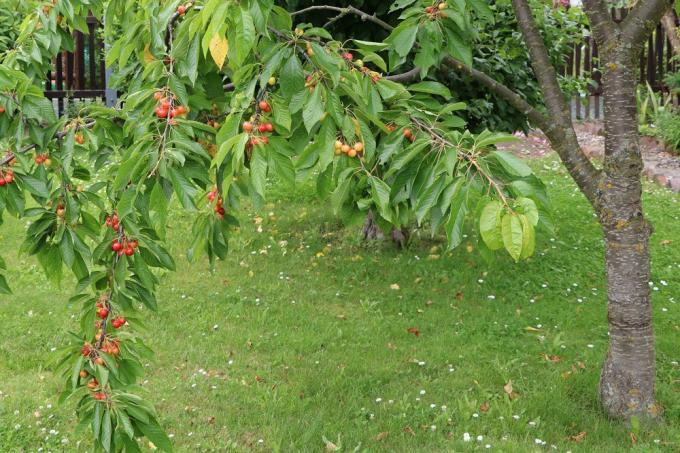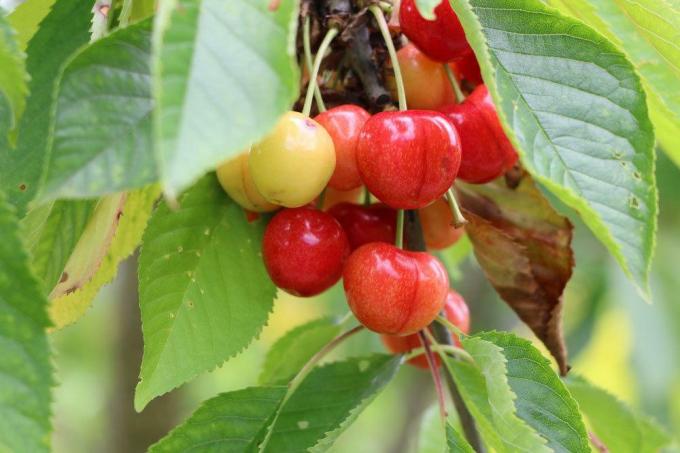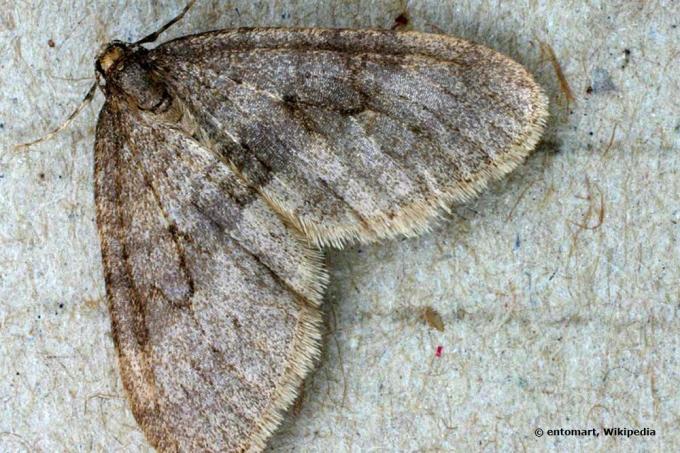
table of contents
- Cherry tree diseases
- Rubber flow
- Monilia fruit rot
- Valsa disease
- Fruit tree cancer
- Shotgun Sickness
- Bacterial burn
- Gnomonia leaf tan
- Fool's disease
- Pests
- Cherry fruit fly
- Black cherry louse
- Frost wrench
The cherry is not only a popular ornamental tree, it is also an interesting option for ambitious fruit growers to harvest their own edible fruit. As with many other fruit trees, problems of all kinds are more common. These can have a negative impact on the health of the crops and thus weaken your possible crop yields. As soon as you realize what disease it is, you can take appropriate action.
Cherry tree diseases
If you have cherry trees in your garden, you may have noticed one or two deficiency symptoms. Cherries can look weaker, especially if the location is not ideal. In contrast to these, there are cherry tree diseases that are caused by bacteria, fungi or other reasons. Numerous cherry diseases can make life difficult for the tree and ruin your harvest. It is important to recognize these in order to be able to take the necessary measures. Therefore, below are the 8 typical diseases that can affect your cherry.
Rubber flow
Gum flow is the leakage of a sticky substance from the bark of the cherry. Over time, this leads to the death of individual branches or trunk parts. Especially with young trees, the flow of rubber can cause the entire tree to die. The disease is mainly caused by an unbalanced water balance, especially when there is too much has been watered or the tree has been planted in an inconvenient place that is very humid over winter is. Remove affected parts of the plant as early as possible, because this is the only way to prevent the disease from spreading. In extreme cases, the cherry tree has to be felled.

tip: The rubber flow is a disease that can appear as a symptom of other diseases and in the long run weakens the fruit tree even more.
Monilia fruit rot
The Monilia fruit rot is one Fungal diseasethat attacks the shoots and fruits of the cherry. If the shoots are attacked, you can tell by the dried up flowers on the branch tips. This then spreads to the entire shoot until it has also dried up and dies. If the fruits are the victim, they will be attacked by a brown mold that is clearly visible. The cherries rot and stick to the tree. If you have this condition, do the following:
- remove infected fruits
- also collect from the ground
- remove infected shoots
Do not take too much time with the treatment, as the fungi can spread very quickly.
Valsa disease
Valsa disease, also known as toad skin, can be recognized by the following symptoms:
- reinforced rubber flow
- Bark becomes "warty"
- The bark is discolored
- Parts of the bark tissue die off
- Rotting fruits
The reason for the toad skin is also an unfavorable location. Cherries should always be in a well-drained location that is airy but sheltered and sunny. Carefully remove the affected areas and then treat the wounds.
Fruit tree cancer
If you are struggling with fruit tree cancer, you will also need to remove and care for affected areas. Fruit tree cancer is caused by a fungus if you prune the cherry tree incorrectly and it has many, untreated wounds. The mushrooms then get into this. It can be recognized by its cracked bark, which is also dry. The wood also discolors and after a long time outgrowths form, which indicate the disease.

tip: When performing the annual pruning measures, always make sure that you use clean, sharp scissors. The more effective your tool, the safer the cut for the cherry tree.
Shotgun Sickness
If your cherry is suffering from reddish spots on the foliage that turn into holes if left untreated, you are likely dealing with shotgun disease. These holes are shaped like the size of shot and accumulate over time until the leaves fall from the tree. The shotgun disease can even spread to the fruits and the shoots until these also die off and consume the cherry even more strength. If you notice this damage, you should pay attention to the following points:
- remove affected branches
- Dispose of fallen leaves and fruits
If you are struggling with shotgun disease frequently, you should consider using preventive measures. These mostly come from specialist retailers and are designed to combat the pathogens. This remedy is used just before the cherries start to bloom, which differs depending on the type and location of the tree.

Bacterial burn
The bacterial fire sounds dangerous and it is. The disease causes the tissue of the branches and the pulp of the cherries to break down. As a result, large holes appear in the cherries, which means that they can no longer be used or even eaten. The bacterial burn, which is easy to recognize by its brownish color, can also lead to rubber flow. If rain then falls on the infected areas, the pathogens drip onto the lower branches. The only thing that helps here is to collect the infected fruit and remove the affected areas.
Gnomonia leaf tan
In the case of Gnomonia leaf tan, only the leaves are attacked. These suffer from brownish spots, which are clearly visible, only in summer due to the warm temperatures. In itself, the disease only affects the vitality of the tree, which cannot cope with the fact that the leaves no longer fall down in autumn. These must be removed, otherwise the infestation will continue until the tree is severely weakened. More work is not needed for the Gnomonia leaf tan.
Fool's disease
You only need to worry about fool's disease if you come across a bird cherry (bot. Prunus padus). Other Prunus species except for the plum (bot. Prunus domestica) are not or rarely infested with the bird cherry. The disease, also known as pocket sickness, shows itself through the following symptoms:
- Fruits: warty, wrinkled, resemble in the shape of a large pod, abnormal growth
- Leaves: misgrowth, crooked
- Shoots: deformity
With all parts of the plant, you must be careful to cut regularly and to carry out these pruning measures effectively and accurately. You should definitely remove infected parts of the cherry so that the tree can recover a little. If the plant parts are not removed, this in turn can lead to infection.

Pests
In addition to the actual diseases, the typical pests of cherry trees should be listed here. Like many other fruit trees, the cherry is an ideal source of food for numerous insects that feast on the sweet fruits and tree sap attack, which in addition to the diseases also has a negative effect on the health of the plants can. Below is a list with an overview of the 3 pests to watch out for.
Cherry fruit fly
An infestation by the cherry fruit fly (Rhagoletis cerasi) can only be recognized by the fruits, because the insects lay their eggs directly in them. The maggots then hatch from these and feast on the cherries. You can recognize the infestation by the fruits, which turn brown, become soft and are no longer edible. To protect your cherry tree and harvest from these pests, apply the following points:
- remove infected cherries
- Hang up yellow boards
From autumn on, you won't have to struggle with these anymore. However, since they mainly attack sweet cherries, they are a thorn in the side of ambitious hobby fruit growers.

Black cherry louse
This pest is also known as the black cherry aphid (Mycus pruniavium / Mycus cerasi) and is a major problem for the cherry tree. Like other aphids, this insect attacks the leaves, more precisely the shoot tips of the cherry trees, and nests there. The leaves curl up due to the parasitic way of life of the lice, can turn brown and even entire parts of the shoots and branches die off over the summer months. Due to the honeydew, the leaves also stick together. It affects the following cherries:
- Ornamental cherries
- Sweet cherries
- Sour cherries
Home remedies do not really help against the robust animals and for this reason only a spray from the trade is recommended. You should treat the cherry with the product before the leaves become more curled in order to effectively contain the infestation, especially if you want to harvest the fruits of your cherry.
Frost wrench
The frost tensioners (Operophtera) are a genus of butterflies that lay eggs on your cherry tree in autumn. From these caterpillars hatch in spring, which then feed on leaves and buds, which robs the plant of a lot of energy. In addition, the loss of buds in sweet and sour cherries causes the bloom to fail, which prevents the tree from developing fruit. This means that a large part of the harvest is lost. The infestation caused by the frost tension can be recognized by traces of feeding on leaves, buds and flowers. The following measures will help against the butterflies:
- Glue rings
- natural predators

The predators of the frost moth include numerous species that feed on caterpillars and adults. These include:
- be crazy
- Beetle
- Caterpillar flies
- Birds
These beneficial insects work effectively against the butterflies and ensure that your cherries are protected in the long term. The more beneficial insects that settle in your garden, the better the cherries are doing, as they enable the natural balance that is required in the garden for healthy fruit trees.
tip: Establish different bird and insect species in your garden, because they feed on the pests mentioned above. So that the beneficial insects feel at home in the garden, you can use a bird house or a Insect hotel put up.
As you can see, it is easy to distinguish between diseases and pest infestation. It must be noted here that a pest infestation can weaken the cherry tree so much that it becomes ill with one of the diseases.




